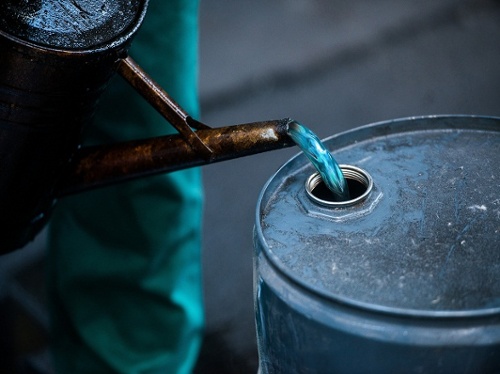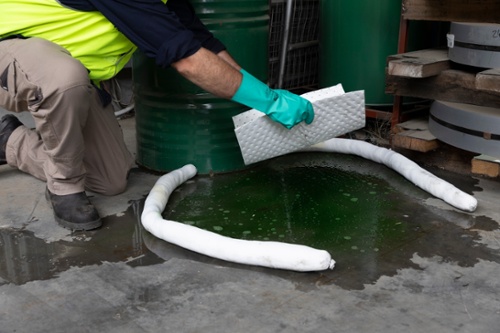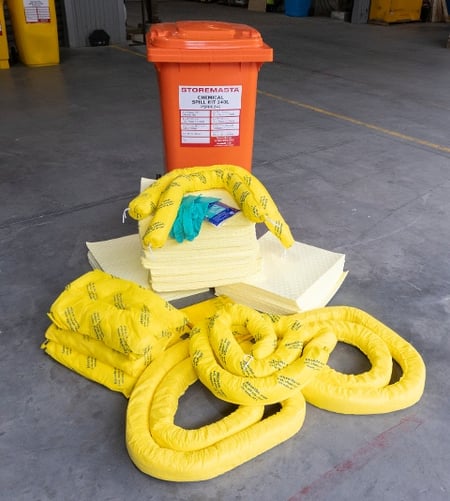Chemical spill kits are your best defence against the many hazards associated with an accidental release of hazardous substances. As your go-to containment, clean-up and decontamination tools, the items within your spill kit will equip your staff to successfully handle any spillage. As you’re probably aware, spills involving hazardous chemicals or dangerous goods can result in serious incidents such as fires, explosions, asphyxiation and environmental damage. Spills must be cleaned up immediately — and effectively — to reduce the likelihood of these events occurring. But first things first: How do you actually use a chemical spill kit in the workplace? In this blog, we’ll be detailing the steps of a successful chemical spill kit procedure, so you can safely contain and manage hazardous chemical leaks or spills in your own workplace.
REMEMBER: Any person who is conducting a business or undertaking at a workplace must contain and manage chemical spills. WHS Regulations state that spillage containment systems must be present wherever a hazardous substance is used, handled, generated or stored.
Identifying Spillage In The Workplace
If you’re carrying any type or quantity of dangerous goods or hazardous chemicals in your organisation, you may be at risk of a chemical spill.
Regardless of the size of the spill, any hazardous substance (or leftover chemical residue) can pose risks to your people, property and the environment.
Identifying spillage in the workplace is crucial for chemical compliance and safety. Afterall, you don’t want to neglect a leak or spill that could result in a serious incident — such as the ignition of spilled flammable substances.

Spillage must be tended to immediately to reduce the risk of incidents such as fire, human harm or environmental contamination.
To minimise the impact of a hazardous substance spill, you must first implement procedures and training that empower your staff to identify spillage — then take immediate and appropriate action.
If your spill occurs in an area which has a secondary containment system, your team can simply access the bunding or spill sump to clean-out and dispose of the spilled substances.
However, if your spill occurs in the general workplace — for example, a forklift leaks diesel throughout your yard — you will have to contain the spill before it spreads even further though your workplace.
Regular inspections of work areas, chemical stores, equipment and machinery are all an important part of your overall chemical safety program. You must also make sure that staff do not simply ignore a hazardous chemical leak — no matter how small or insignificant it may first appear.
Spill Kit Instructions
We also recommend developing clear instructions on how to use your spill kit. Laminate these instructions and keep them safely tucked away in every spill kit that you have onsite.
While the instructions should not be the only information that your staff have about how to use a spill kit, it’s important to keep these documents with your kits so there is no confusion about the spill clean-up process — or the equipment that’s available in your specific spill kit.
Chemical Spill Awareness
Once a spill has been detected, nominated staff should be able to confidently manage the clean-up of the hazardous chemical spill. Providing a timely response to workplace spillage can turn a potentially hazardous situation into a safe and compliant clean-up process.
Implement a comprehensive training program, so that nominated staff can act quickly and decisively in the event of a chemical leak or spill.

Any worker handling hazardous chemicals should be aware of how to prevent and manage spillage.
By encouraging chemical awareness through clear communication, regular inspections and strict housekeeping procedures, you should be able to detect any leaks or spills which may occur in cabinets, storage containers, handling areas or general workspaces.
IMPORTANT: You’re obliged, under WHS Regulations, to immediately clean-up a chemical leak or spill. You must also safely dispose of the spilled substances, soiled materials and any effluent which is the result of the spillage.
Need a Spill Kit Checklist?
Chemical Spill Procedure
As we’ve mentioned in the previous section, once your staff are fully trained and have strict procedures to follow, they should be armed with both the skill and knowledge to handle a hazardous chemical spill clean-up.
Never allow a single staff member to tend to a chemical spill alone. Make sure only fully trained staff are allowed onsite, and offer supervision of the entire clean-up and waste disposal process.
REMEMBER: If your staff are dealing with a major incident (such as an overturned fuel tanker), then you must action your emergency plan, evacuation the area — and notify local emergency services and regulatory authorities.
The following are some of the simple steps that you can take when facing a hazardous substance spill or leak in your workplace.
1. Assess The Risk
As soon as a leak or spill occurs, your nominated staff should be informed so they can accurately assess the risk. Workers should be able to correctly identify the substance and spill volume to determine the level of risk associated with the spillage.
During this assessment, make sure that the spill site is free from unathorised personnel. Also ensure that any further hazards (such as ignition sources or incompatible chemicals) are quickly removed from the area.
2. Put On PPE
Your PPE is an integral part of your spill kit – and essential for the clean-up process. Before tackling the hazardous substance spill, your staff must access the appropriate PPE including the required clothing, footwear, gloves, eyewear and/or breathing apparatus.
3. Access The Spill Kit
Your fully trained staff should be able to quickly gain access to the kit relevant for the spill site. The kit should be in excellent condition, fully assembled and with no missing or damaged items.
Your chemical spill kits should be located in a well-lit, designated position within 30 metres of each spill risk area.
Staff should be equipped with a complete kit that is suitable for the type of chemical that has been spilled.
4. Lay Down A Safety Barrier
The next step in the spill clean-up is to lay down a barrier around the spill area. Depending on the spill kit that you have for your chemical product, there may be containment barriers such as absorbent mini booms to prevent chemicals from spreading further into the workplace.
Make sure that any drains or sewer systems are also plugged or separated from the spillage, as hazardous substances could travel down the system into waterways or the surrounding environment.
5. Stop The Leak
Every spill is different. Some may involve a leaking chemical drum, while others may be an uncontrolled spill caused by faulty equipment. Whatever the case, it’s imperative that the chemical leak is stopped as quickly and as safely as possible.
This may be achieved through simply plugging the leak, closing a valve, or simply setting chemical containers in the correct upright position.
6. Absorb The Spillage
Your spill kit should be specifically designed to contain and manage the chemical spill. You may find a range of absorbent items in your kit that you can use to soak up the spill. Absorbent items may include pads, pillows, floor sweep — or even some old socks. However, keep in mind that each absorbent item may be more suitable to a specific task during the clean-up of spilled chemicals.

Suitable applications for absorbent items include the following:
- Absorbent pads – place the pad on the ground to absorb the spillage underneath
- Pillows – these items are ideal for placement under leaking equipment
- Floor sweep – as a granulated absorbent, the floor sweep is an alternative to the absorbent pad. It can be spread over the spillage, assisting in the removal of the substance through the penetration of the spill surface.
IMPORTANT: When creating and maintain a spill kit, make sure that the materials within the kit are compatible with the chemical that may be released. Certain chemicals, such as flammable liquids, require specific absorbent materials to minimise the hazards associated with chemical spillage.
7. Clean-up The Spill Site
The next step in the process is performing the clean-up of the spill site. You may have to wipe down floors, walls, stores or equipment so it’s free from any residual contamination.
Most chemical spills will require a decontamination of the site, so that no harmful residue remains after the clean-up process.
During this clean-up period you should also make sure that the air quality in the spill site is safe for workers. Large spills may release high concentrations of hazardous vapours which must be dispersed by natural or mechanical ventilation. Failure to do so may result in non-compliance and health hazards if vapour levels exceed the legal limits of the workplace exposure standards.
8. Dispose Of Contaminated Chemical Waste
Chemical waste and residue can contaminate PPE, absorbents, booms, equipment and other workplace items. It’s important that chemical waste is placed in the designated waste bags for collection by authorised waste management providers.
Waste bags should be securely tied up so no further spillage occurs during the waste disposal process.
9. Report The Spillage Incident
Reporting any incident in the workplace is essential for the ongoing compliance and safety of your organisation. Create procedures for reporting hazardous chemical leaks or spills, so your team can work together to minimise risks in the immediate future. We suggest discussing any workplace health and safety issues at the following staff meeting, so that corrective actions can be taken to minimise the likelihood of a repeat incident.
Protecting Your Organisation From Chemical Spills
Whether you’re cleaning up a small container of flammable liquids that’s been dropped on your workshop floor, or you’re dealing with a split IBC that’s leaking toxic chemicals over your loading dock, we hope we’ve armed you with the spill kit basics with this chemical spill kit procedure. You may use this blog as the basis for your spill kit staff training. And don’t forget to create your own instructions – which should be laminated and kept with each of your workplace spill kits.
To find out more about the safe management of your onsite chemicals, you can download our easy-to-read eBook. How To Manage The Risk Of Hazardous Chemicals In The Workplace will help you reduce your chemical risks, such as spillage, by introducing you to our 4-step risk control methodology. It also includes a risk management matrix template, so you can determine your pre- and post-mitigation risks. Get your free copy of our guide today by simply clicking on the image below.
Joining the team as a Dangerous Goods Storage Consultant, Melissa Hampton became Storemasta's Marketing Manager in late 2021. With extensive knowledge and experience in chemical compliance, Melissa is responsible for leading the Marketing team and helping shape their marketing strategy. In her spare time, you can find Melissa hiking, swimming and enjoying the great outdoors in beautiful north-west Tasmania.

